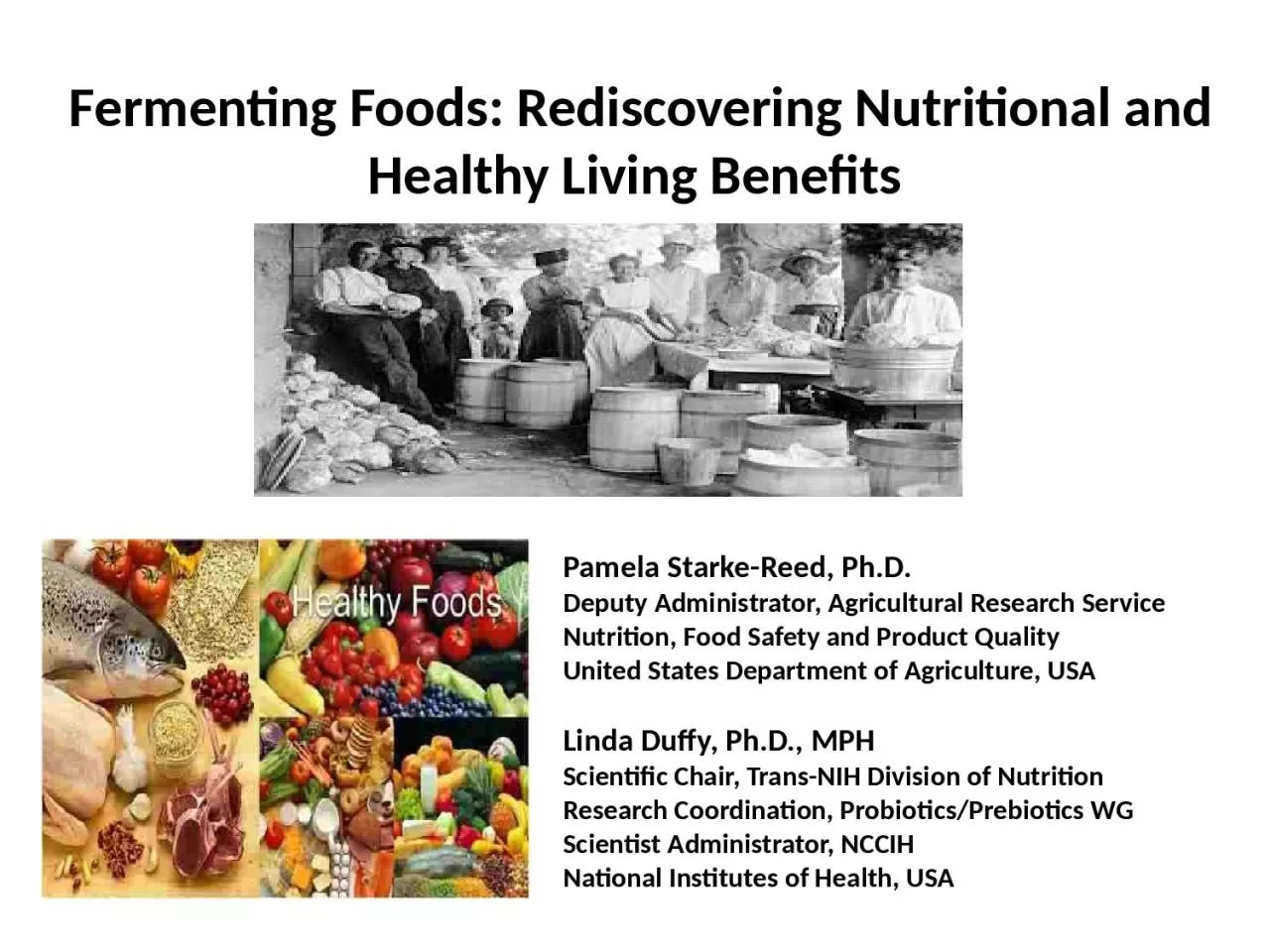

Pamela StarkeReed PhD Deputy Administrator Agricultural Research Service Nutrition Food Safety and Product Quality United States Department of Agriculture USA Linda Duffy PhD MPH Scientific Chair TransNIH Division of Nutrition Research Coordination ProbioticsPrebiotics WG ID: 1039097
Download Presentation The PPT/PDF document "Fermenting Foods: Rediscovering Nutritio..." is the property of its rightful owner. Permission is granted to download and print the materials on this web site for personal, non-commercial use only, and to display it on your personal computer provided you do not modify the materials and that you retain all copyright notices contained in the materials. By downloading content from our website, you accept the terms of this agreement.
1. Fermenting Foods: Rediscovering Nutritional and Healthy Living BenefitsPamela Starke-Reed, Ph.D.Deputy Administrator, Agricultural Research ServiceNutrition, Food Safety and Product Quality United States Department of Agriculture, USALinda Duffy, Ph.D., MPHScientific Chair, Trans-NIH Division of Nutrition Research Coordination, Probiotics/Prebiotics WGScientist Administrator, NCCIHNational Institutes of Health, USA
2. Definition of FermentationWhat is fermentation?An anaerobic cellular process in bacteria, yeast or other microorganisms convert foods into simpler compounds and chemical energy (ATP) is produced.Fermentation in food processing is the conversion of carbohydrates into alcohols and carbon dioxide or organic acids by yeast, bacteria or combinations of both.What are fermented foods? Foods processed for example, through lacto-fermentation wherein natural bacteria feed on the sugar and starch, creating lactic acid. This process biopreserves the food, creates beneficial enzymes, b- vitamins, omega-3 fatty acids, and probiotic bacterial strains.
3. FERMENTATION
4. FermentationTwo types of fermentation Alcoholic vs Lactic Acid Fermentation
5.
6. Fermentation Food Products and their Uses Carbon dioxide – bread making using baker’s yeast Alcohol – wine making and brewing using yeast Lactic Acid – lactic acid bacteria ferment milk into products as yogurt; Sauerkraut, fermented cucumbers, and kimchi are the most studied lactic acid fermented vegetables.
7. Biopreservation in Different Food Products
8. Origins of Some Fermented FoodsFoodApproximate yearof introductionRegionMushroomsSoy sauceWineFermented milkCheeseBeerBread Fermented MeatsSourdough breadFish saucePickled vegetablesTea4000 BC3000 BC3000 BC3000 BC2000 BC2000 BC1500 BC1500 BC1000 BC1000 BC1000 BC 200 BCChinaChina, Korea, JapanNorth Africa, EuropeMiddle EastMiddle EastNorth Africa, ChinaEgypt, EuropeMiddle EastEuropeSoutheast Asia, North AfricaChina, EuropeChina
9. Benefits of FermentationBenefitRaw materialFermented foodPreservationMilk(Most materials)Yoghurt, cheeseEnhancement of safetyAcid productionAcid and alcohol productionProduction of bacteriocinsRemoval of toxic componentsFruitBarleyGrapesMeatCassavaSoybeanVinegarBeerWineSalamiGari, polviho azedoSoy sauceEnhancement of nutritional valueImproved digestibilityRetention of micronutrientsIncreased fibre contentSynthesis of probiotic compoundsWheatLeafy veges.CoconutMilkBreadKimchi, sauerkrautNata de cocoBifidus milk, Yakult, Acidophilus yoghurt
10. LACTOBACILLUS FERMENTATION
11. Lactic Acid BacteriaLactic acid bacteria have been used to ferment or culture foods for at least 4000 years. Examples: products like yogurt and cheese
12. Transit of Food Through the Human GIT David L. Topping, and Peter M. Clifton Physiol Rev 2001;81:1031-1064
13. Effects of Probiotic Bacteria and Yeast Christina L. Ohland, and Wallace K. MacNaughton Am J Physiol Gastrointest Liver Physiol 2010; 298:G807-G819
14. Microbial Fermentation and Effects on Host Functional Properties
15. Probiotic Benefits in Food Consumption Being Studied
16. Sources of ProbioticsSources of PrebioticsFunctional Fermenting Foods Research
17. In fresh cabbage, vitamin C is bound in the cellulose structure and various other molecules, and our digestive system is just not able to cleave it off and absorb it. Lots of it goes undigested and come out right out of you. So despite the fact that cabbage may be very rich in vitamin C, most of us will not be able to absorb. However, by fermenting the cabbage [sauerkraut; kimchi], all the vitamin C becomes bioavailable,” KIMCHIFermentable Cabbage Probiotic Functional Foods Cabbage is high in anti-inflammatory properties, vitamins A and C. Cabbage also reduces lipids in the bloodstream. When cabbage is fermented into sauerkraut the fermentation process opens up the cell walls accessing a higher ratio of vitamins. It has been said that sauerkraut has 200 times more vitamin C than the head of cabbage before fermentation.cabbage
18.
19. Fermenting Foods Bio-Fortification as Alternative Strategies for Improving Nutritional Status